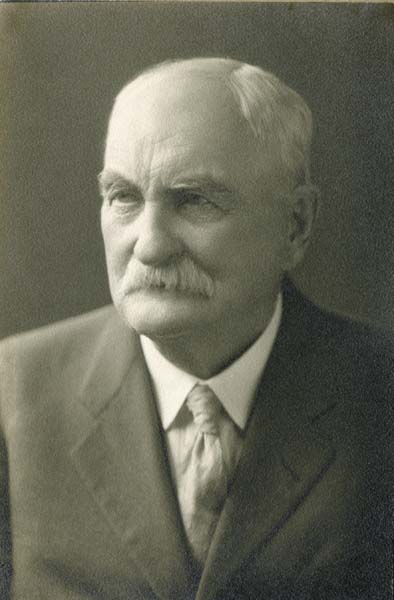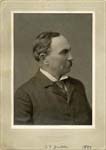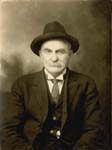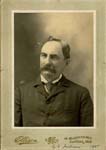Chester Eliphalet Jackson,
1845-1930
Of all the characters back
along branches of my extensive family tree, Chester Eliphalet
Jackson easily qualifies as the most fascinating. Farmer,
explorer, diplomat, husband, father, speculator, orchardist, legislator, traveler and finally
grandfather --
his was clearly a varied and exciting life. We may be grateful he
took time to court and marry Eliza Frances Keys and with her
raise three girls, one of whom was my grandmother.
This section, in multiple
pages, contains links to many documents and not a few
photographs, and some of the documents are lengthy. The
portrait above is just one of Chester found in the files; others
are below:
I will not repeat Chester's
biography. That document was prepared several decades
ago, and recently updated to account for some recent discoveries. The biography is contained in the
Chester E. Jackson monograph PDF (**
REVISED 4/10/12 **).
The remainder of Chester's
history is presented in a series of documents most of which were
discovered since the writing of the biography (selected scanned
or extracted correspondence is on the
next page) -- many of these
documents will appear reduced on the screen; use the
cursor-magnifier glass to enlarge.
I have included comments offered
when the letters were originally circulated to family. I have
also included some family members' responses to my original email --
my most prolific responder, my uncle Richard Bates, is identified as
"RCB".
-
Before any of his trips,
on January 4, 1870, Chester executed a
short-term promissory note for $250 (equivalent to $4256
in 2010), for purposes unknown.
RCB:
After father Jacob died, Chester was burdened
with running the farm and keeping things together for young
brother Charles. His mother, Fannie Goodrich, was mentally
impaired at middle age. I have seen one of her attempts to
write which suggests that it was organic brain damage rather
than a psychosis. Chester's trip down the Mississippi was a
winter relief from the considerable burdens at home.
He must have borrowed money to meet a shortage of cash
between crops -- you remember my discussion of how La Mott
profited from bailing out farmers.
However, when your Mother visited Charles in New Jersey she
asked him why Chester left the farm and he retorted,
enigmatically, "Girl trouble".
Chester never went back to visit his mother and never
mentioned her to his daughters. As you know, he wrote an
extensive biography of his father.
Grandma [Jackson] was recalling today Grandpa's experiences
in New Orleans as a young man fresh from the farm, kind and
gullible. Some sharpsters (I don't know how but probably by
chance or card game) fleeced him out of 70.00 & forced
him to send home to his father for funds! I wrote to
Jack -- "Let this be a lesson to you."
That's $103 in 1942 dollars and $1373 in 2010's.
RCB:
Sorry, Mother. Chester's father, Jacob, died in
1871 whereupon Chester took over the running of their Racine
farm. It was to escape the monotony of farming during the
winter months that Chester, age 29, took off down the
Mississippi in 1875. Perhaps he wrote back to his younger
brother or his mother for more of the farm money.
-
In preparation for the
Orinoco expedition, Chester needed a passport to Venezuela.
I have the
original of that passport, signed January 20, 1876, for
all we can tell by the famous Secretary of State Hamilton
Fish, and it is amazing if for no other reason that it is 18
inches high! Other features:
1) Issue date is 1/20/1876. Chester notes in the Orinoco
Diary that they picked up the passports in NYC on 1/24. In
his separate recollections regarding the trip, he notes
consulting an attorney in Rochester on 1/19 or 1/20 about
getting the passports, so we may conclude that the
information was wired to D.C., the passport issued almost
instantly, and the document couriered to NYC by train. Try
to get that kind of service today!
2) Note how they dealt with physical description in days
before photography.
3) He was issued a Venezuelan visa in Trinidad on
2/10/1976. This is nowhere mentioned in either Diary or
recollections.
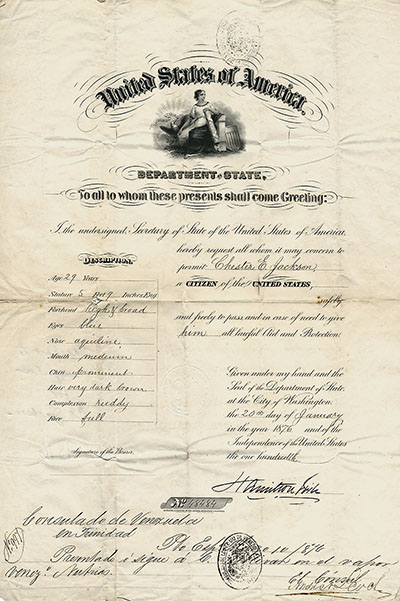
-
The Orinoco Diary -- Chester's account of his expedition
to the Orinoco River in Venezuela, accompanied by William
Temple Hornaday, who would later become one of the
preeminent naturalists of his time and founder of the Bronx
Zoo. (The Diary is also part of the Chester Jackson monograph,
above. The version presented in both locations is low
resolution; some of the maps will not zoom well; a high
resolution version is available.)
Note from Gregory Dehler, who did his PhD thesis on Hornaday,
4/3/2012: "[In the Library of Congress archives is] a
copy of the contract between Ward and Chester for the South
American expedition. I thought it was interesting that Ward
paid Hornaday a salary and Jackson received a percentage of
all that he collected. The rate was 5% of the specimen
value."
-
Letters from William Hornaday, 1876-79 -- written by
Hornaday while on his second major specimen-collecting
expedition, this one via London and Paris to India, Ceylon
(Sri Lanka), Singapore and Borneo. These letters were
discovered only recently in materials handed down from
Chester to his daughters to Emily (Bates) Haynes to myself,
and were heretofore unknown to Hornaday biographers and
researchers. (The letters will be mentioned in a
forthcoming book about Hornaday written by Gregory Dehler.)
All the letters contain multiple interesting details of
Hornaday's travels and adventures, but for us descendants of
Chester Jackson, Hornaday's advice on romantic matters is of
special interest given Chester's marriage five years later
to Eliza Keys. William Hornaday
writing Chester from Paris in December 1876 (six months
after return from the Orinoco expedition):
Just now, nothing can dash my spirits to any extent.
Everything is perfectly square and lovely at home. I am
in splendid fighting trim, and have untold happiness at
the end of the struggle ready and waiting for me with
open arms [reference to his future wife, Josephine]. Old
fellow, I do wish you would fall dead in love with Miss
____, for you would immediately find yourself in another
world entirely. There's absolutely nothing like it! For
my part I feel a calm and happy tranquility -- all the
while all tasks are play, and I seem to tread on air.
Because I know she's true! Well, now, don't be afraid to
love the girl for fear she can't be lassooed. My pard,
that's the very way to win her. My word for it, only
love her enough and she's yours. Like begets like, and
if she won't capitulate without a siege, just lay siege,
and sooner or later she must surrender. A siege will in
time reduce any fortress. Darn my eyes, I believe I
could win almost any girl that I set my head to, not on
my merits I beg to assure you, but by pure force of arms
and unceasing persistence.
... [I]t's decidedly dangerous to ever tell a fellow
you wish he would marry a certain girl, for as sure as
you do he will go off and marry some other girl, or else
none at all. Such is nature! But pard, your years are
slipping by, and it's time you had a young one on your
knee yelling for a tin whistle or a shingle off the
house. I don't want to see you an old bach, for then how
in the old Harry am I to bring my wife to see you?
... Now Chet, I am sure you esteem the L__ark very
highly, and if some other fellow was to come along to
carry her off, you'd wake up as sharply as you did that
time when the ant bit you in the night on the Toro! But
then you're near the game and can keep an eye on it. But
I must say no more since I really hope you will fall
dead in love with her, and you are sure not to if I tell
you had better and hope you will. Henceforth I must hold
my peace and and await developments.
The letters' other
contents:
1) The perfect gift to give one's beloved before setting off
to travel to London, Paris, India, Ceylon, Singapore and
Borneo.
2) The approximate date Chester learned of his appointment
as U.S. Consul to Antigua.
3) Use of the phrase "white feather" years before I thought
it gained currency. (Turns out it had actually been in use
since early in the 19th century and was a fairly commonly
used phrase by the time Hornaday wrote the letter.)
4) A man romanticizing Mary Queen of Scots long before the
movies (but after Donizetti wrote his "Maria Stuarda") and
providing first person account of vandalism done to her tomb
in Westminster Abbey, which was itself also defaced by
graffiti.
5) Several descriptions of rapacious trophy killing, from a
man who would -- in a seeming paradox -- found the exemplar
of all zoological parks, the Bronx Zoo. One letter dealt
with hunting in India at the height of the "British Raj,"
when servants could be hired for $2/month.
6) A first-person account of the consequences in London of
heating with coal.
7) A comparison of English and French cuisine 130 years ago
(guess which one wins).
8) Hazards of doing naturalist field work (hint: you become
part of the menu).
9) An ode comparing the love of a sweetheart with bonhomie
of a male friend.
10) You will learn that Lizzie seems to have spurned
Chester's first proposal of marriage! (This is my
conclusion, although some later evidence suggests it may
have been an earlier belle -- consider the censored name on
p. 61. And then read p. 95 for a real eye-opener.)
-
**
NEW (4/7/12) ** Chester was
appointed U.S. Consul to the British West Indies colony
of Antigua (and Barbuda) on July 18, 1878. Signed by
Frederick W. Seward, Assistant Secretary of State, son of
the man famous for "Seward's Folly" -- the purchase of
Alaska. (Original
document held by Jeffrey Haynes.)
-
** NEW
(4/7/12) **
Her Majesty's government accepted Chester's Consul
appointment by
a sealed document bearing -- to all appearances -- Queen
Victoria's signature ("Victoria Reg") in the upper left
corner, dated November 6, 1878. We do not know where
the confirmation was sent to Chester, although I suspect it
must have been to Antigua.
-
In March 1879, after he
became engaged to Eliza Keys, Chester returned to Antigua to
resume his Consul position.
He kept a journal during the voyage, which he also
directed to Eliza and sent to her upon his arrival.
(You may view
a second version of the journal which includes the
handwritten pages.)
Can one come to understand a man 80-years dead? Would a man
raised under Victorian or even Puritan mores unburden
himself sufficiently, and his writing saved for 132 years be
intelligible to us his far distant descendants, such that some
great portion of the man comes through so that we better
comprehend what made him tick?
You'll need to judge for yourself, but based on this
document, I think so.
On Chester Jackson's voyage to Antigua in March-April 1879
he had plenty of time to anticipate his forthcoming marriage
to Eliza Keys. So he poured out his thoughts in fifty pages
of a small pocket diary, which he then mailed to Eliza upon
reaching Antigua. This is in effect a 50 page-long love
letter and confession.
-
In 1880 Chester
sought to have Congress increase the funding for his
Consular office. He
renewed the request later that year.
-
Chester
married Eliza Frances Keys on April 15, 1881, in Holley,
NY. Their
wedding invitation. They returned to Antigua,
where Eliza bore them three daughters, Myra (1882), Wilma
(1884) and Beulah (1885).
-
In approximately 1881,
American Export Journal published an article
speaking favorably of Chester's efforts in Antigua.
-
Chester worked with the
Antiguan legislature to enact an
exemption from import duties
for items brought in for
exhibit, in effect in February 1881.
-
Chester's cousin William
Jackson lived in Jackson, MI, in 1883; Chester wrote
an article for publication in the Jackson newspaper
describing fruit to be found on Antigua.
-
Twice during his tenure
in Antigua -- 1884 and 1889 -- Chester had
auctioned goods held or owned by the Consul's office.
The reason for the auction is unclear; so far as can be
determined proceeds from the auction went into supporting
the Consul's office. (My current speculation:
items sent to the Consul for display as U.S.-manufactured
goods were auctioned after their exhibition.)
-
In a matter of little
import, in 1884 Chester was
solicited by persons on another B.W.I. island for a
financial contribution to support a U.S. Consular Agent
whose home had been destroyed by fire.
-
By 1886 Chester's
efforts as U.S. Consul were well
appreciated by the Antiguan press.
-
"Something
About Sharks" - a piece Chester wrote in 1886, perhaps
intended for publication.
-
On August 2, 1887,
Chester purchased "the balance of the stock of the old
issue of the fourpenny (4p) and sixpenny (6p) postage
stamps, belonging to the [British] Virgin Islands."
For those of us in the family who have lived with this
"legend" -- suspected by some as apocryphal -- this is the
smoking gun: the certificate apparently acquired and then
used by Chester Jackson to authenticate his 1887 purchase of £56 of Virgin
Islands stamps that he then held for
sixteen years, took to England, and sold for enough money to
fund the building of the Jackson-Bates family home in Ovid,
which comprised a substantial portion of Grandma's estate in
1981.
How many can trace the growth of an investment/asset through
only four transformations (cash-to-stamps [1887],
stamps-to-cash [1904], cash-to-house [ca 1907], and
house-to-cash[1981]) -- over 94 years?
This clears up one thing -- Chester did not take advantage
of his position as Consul to buy Antiguan stamps -- the
stamps purchased were apparently of the British Virgin
Islands. (They could not have been stamps of the Danish
West Indies, since those islands did not become the U.S.
Virgin Islands until 1916.)
By the way, £56 in 1887 equals $2,878 in 1981 dollars; the
house was worth many times that.
RCB: "I have believed that he made a big profit
because there was a rush by British philatelists to collect
stamps from all the Commonwealth countries."
-
The President of Antigua
wrote a
quaint congratulatory proclamation
on the occasion of July 4, 1888.
-
Journalist and author
Poultney Bigelow visited Antigua in 1889, met Chester and
family, and in 1889-90 wrote "A Cruise Around Antigua" for
The Cosmopolitan -- parts
1 and
2.
-
Again, sometime during
his stay in Antigua, he wrote "A
Sunday Walk in Antigua," perhaps intended for
publication.
-
The "Last
Will and Testament of George Martin." Martin, apparently a
resident of the British Virgin Island of Tortola, executed
his will in 1816. A typewritten copy of the will was in Chester's
files, but we have no hint exactly why he acquired it. The only indication that it comes from his period as
U.S. Consul was a note by Grandma or one of the aunts saying
"Antigua."
It is dense, and hard to read (a function of its time of
writing), but very, very interesting in portraying this man
George Martin, apparently a wealthy white individual living in
Tortola, one of the British Virgin Islands, where at the
time of writing slavery still existed. (See Wikipedia's
article on
Slavery in the British Virgin Islands.) We don't often
see the word "manumit" these days.
Examining the original document, I saw that the paper has a
watermark -- the watermark of the U.S. Department of State.
I've concluded that either, 1) Chester came across the
document and had it transcribed by his office staff
(although I doubt he would have seen a Tortola document in
Antigua); or, 2) his counterpart consul on Tortola had seen
the document, had copies made and then circulated them as
"curiosities" to his counterparts on other Caribbean
islands.
Chester, being solidly from the north and with the Civil War
still fresh in memory, may have found this either a)
curious, b) abhorrent, or c) liberating.
-
Sometime during his time
in Antigua, we may presume, Chester recorded "The
Song of the Katy-did," in a Caribbean dialect. And
also at some point he recorded a bunch of what he called "West
India Proverbs," in Caribbean native dialect.
I can't authenticate their authenticity, although similar
versions of some of the Proverbs may be found in Jamaica.
-
Presumably after Eliza
returned to Holley, NY,
Chester rented quarters in St. John, Antigua for a month
in January 1890.
-
In 1890, Chester was
reported in
a local news item to have opened a quarry near Holley,
NY. (Holley was the hometown of his wife, Eliza.)
This venture must have been short-lived, since he moved soon
thereafter to Ovid, MI. (Another contemporary Holley
Keys family member also had a quarry venture at about the
same time.)
-
Undated clipping saved
by Chester Jackson, probably ca. July or August 1890:
"Mr. C.E. Jackson, late U.S. Consul at Antigua, West India
Islands, and a brother-in-law of Mr. H.N. Keys of this
place, sent a few days ago to the latter gentleman a
painting of Saint Thomas, one of the apostles. It was a
rare painting and Mr. Keys found that the 149 years since it
was executed had told upon it and as he is considerable of
an artist himself, at once set about to restore it to its
original appearance and had it insured for $300. Mr. Keys
is the custodian of numerous relics of his brother-in-law
and this one especially should be seen to be admired. He
wished to know a little more of its history and so wrote to
a friend at Buffalo and received the following reply:
Buffalo, July 28,
1890.
Mr. H.N. Keys, My Dear Sir:
'St. Thomas' was painted in 1751 in Mexico, by
Michael [Miguel] Cabrera, of the school of Murillo,
and is one of a set of four apostles painted by him at
that time. Of the other three I have 'St. John.'
Cabrera had a commission to paint 20 large pictures for
a monastery at Tepozottan, for which he received
$10,000. When Juarez came on deck after the overthrow
of Maximillian, his men sacked the monastery and its
paintings, after several years came as so much rubbish
into the hands of my friend Sr. Eufemio Abadiano, an art
conneisuer [sic] of Mexico City, who sold the two to
me. Am glad Thomas arrived safely; I paid the freight
on him as far as I could.
Yours truly,
W.T. Hornaday
"Mr. K. will soon have
the picture ready to be seen and will set apart some evening
when he would be pleased to have any of his friends call and
view it."
Randall Smith presently has this painting, hanging in his
home.
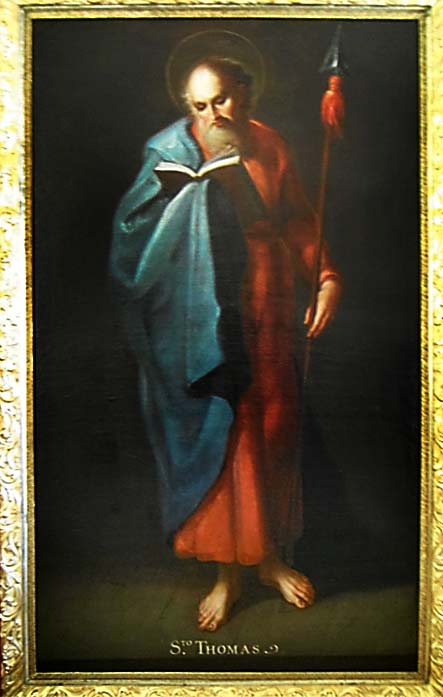
Randy's comments (3/20/2012) regarding
provenance and present situation of the painting:
Yes, this information was copied to the family shortly
after the life size oil painting arrived safely here in the
early 1980s. Your mother forwarded the original Hornaday
letter to Uncle Horace on receipt of her share of the cost
paid to each sibling. She had wanted the painting donated
to an art museum in Grand Rapids, but I rather strenuously
objected and offered to purchase it for its appraised value
rather than have it leave the family.
Hornaday's letter dated 28 July 1890 on Union Land
Exchange, Buffalo, NY., 'W. T. Hornaday, Secretary,'
stationery is framed next to the painting .... As you know,
Chester traded a complete suit of Japanese armor to Hornaday
for the painting.
The painting was in Ovid for more than 90 years. Uncle
Horace's rather primitive repair of holes in the canvas and
burn marks on the portrait were professionally repaired with
a thorough cleaning and restoration in San Francisco. The
entire work was reframed including the narrow original
frame near the century anniversary of the image coming to
our family.
Most of Cabrera's work was destroyed by revolutionaries in
the 1860s as he was considered a Spanish colonial artist.
However, if you get to Taxco, the cathedral there has
several of his pieces which are very recognizable from the
image so familiar to us.
Ezekial
DeCamp lived in the big house to the East. His daughter,
Antha DeCamp, married Eliza's brother, Horace Keys, who
worked for his father-in-law in the bank and is the notary
on this paper. Horace was responsible for getting Chester
to come to Ovid from Holley, NY.
So, Chester didn't buy the farm in one lump sum after
returning from England where he sold the stamps: there was a
[prior] mortgage on the balance.
SLH: Actually, I think he purchased the entire land
with proceeds from the mortgage, then used the stamps
proceeds to build the house.
Grandpa Jackson's orchards gradually deteriorated with age
and black spot. Perhaps he wasn't as careful with spraying.
The 'cold storage' was a special barn straight north from
the house designed purely for storing apples which were
piled in bins in the basement. There, they were prey to
hordes of rats which [brother] Jack and the hired man's son
enjoyed shooting with BB guns. When they had killed 100
rats, the Aunts put on a special lunch for them with dishes
named for their achievement. I remember 'ratatouille' for
one.
Father [Bion] felt that Grandfather should sort out the
good, unblemished apples and sell them at a premium, but
Grandfather felt that the good apples would help sell the
flawed ones which he did with poor success. One year he sold
the whole crop on contract whereupon the wholesaler
proceeded to do just what Father suggested.
Aunt My
[Myra], Grandma [Eliza] and the hired man tried to keep
up the orchards after Grandfather died but the apples
were scabby and only good for cider. After Father
and Mother [Wilma] moved up to the Jackson house, Father
had a bull-dozer push down 40 acres of old trees, piling
them in windrows. He cut a lot of them up for
firewood which was stored in the main barn and
advertised for sale in the Lansing paper. There wasn't
much demand for it, although apple wood is much prized
for fire-place fires.
-
In April 1896 Chester
sent the Virgin Islands stamps to a bank in New York
City (valued at $4,324.50), presumably in an attempt (first
attempt?) to sell them.
-
Chester Jackson's
1897-98 service in the Michigan Legislature was
recorded in an undated document.
-
In 1903, Chester
traveled to England to sell the British Virgin Islands
stamps he had purchased near the end of his Consulship in
Antigua. He kept
a journal.
Unfortunately, he did not record the sale price.
-
A
tinted photograph or etching Chester received from
Hornaday with a note: "A Sheep-Hunter's Camp-Fire / On
Rattlesnake Mountain, Wyoming, Nov. 14, 1889 / To Chester E.
Jackson, Mar. 4, 1905 From W.T. Hornaday." (The
print hangs on our wall.)
Note from Gregory Dehler, who did his PhD thesis on Hornaday,
4/3/2012: "I went through some of my notes from the
Library of Congress. Because I was pressed for time I did
not make any copies. I have some notes for a letter WTH
wrote to 'Pard' in August 1905 before he set out for his
hunting trip in British Columbia (covered in Campfires on
the Canadian Rockies). I would guess he sent that photo
(what a great family heirloom!) around that time. He was
clearly thinking of his old hunting partner when setting out
in a new venture."
RCB: "Grandpa Jackson had a rack of mountain goat
horns like those in the picture nailed to the wall outside
the back door. I've always wondered where he got them."
-
Letterhead in Chester's
documents (letter date 1/21/1912):
CHESTER E. JACKSON
County Agent
for
State Board Corrections
and
Charities
Clinton County
We know nothing of this
duty.
-
Chester writing Beulah
Jackson, 4/14/1912 (extract):
"We saw in the St. Johns paper that Nelson Keys had got his
foot crushed way down in southern Indiana by the cars and
that Bertha had gone to him. Today Ma phoned Bertha & found
that she had brought Nelson home on a stretcher, his foot
having been amputated before B got there, I believe. Bad
business. It seems he was walking on the track and slipped
before a freight train."
This refers to Nelson Rowell Keys, b. 1892.
RCB: "I'm skeptical of the report of how it happened.
This was a fairly common accident to people who were
'hopping freights' and missed a hand hold on the moving
car."
-
Chester letter re
hunting bobcats -
2/12/1915. No one writes like this anymore:
-
Your lively and
most acceptable epistles of date the 6th inst came in
quick time and were as stimulating as Mountain air and
the bellowing of hounds in the chase of the elusive
bob-cat.
So begins a Chester
Jackson letter dated Feb. 12, 1915. The letter may be a
draft of what was actually sent; the original is now held by
Randall Smith.
-
A significant event:
burning of the Jackson barn on September 28, 1916.
RCB:
This is a priceless family annal that I had no
idea existed. I've long had an impression that someone once
told me that Aunt My [Myra Jackson] was responsible for the
barn fire, but haven't repeated it for fear I was wrong.
Not only does [this] document a huge fire that almost
burned down two houses and another barn, but it discloses
something about Chester's personality and an event that
probably changed Myra's. Her honesty is admirable. Maybe
this is part of why she never married?
The house next door belonged to the Lowe's -- originally the DeCamps.
Chester roofed over the basement of the barn and used it
for a tool shed. I presume he used the insurance money to
buy the big main barn. The "cold storage" was, I think,
built when I was very young.
-
In January 1920 Chester
visited Bermuda, and during the trip took a guided tour of
Bermuda's Crystal Cave. He
recorded his impressions in a diary given to his
daughter Wilma.
-
In 1921 Chester made a return
voyage to Antigua and other Caribbean
islands. He obtained
a new passport for the trip. Photos from both the
Bermuda and Caribbean trips (less Antigua) are in one
PDF (the PDF denotes the Caribbean part as occurring in
1919 -- that's a mistake, since it was in 1921), and the
Antigua visit portion of the Caribbean trip is in
a separate PDF.
-
Some time after 1921
Chester
annotated a Western Hemisphere map showing his various
trips and voyages (ignore the red lines, which are part of
the printed map).
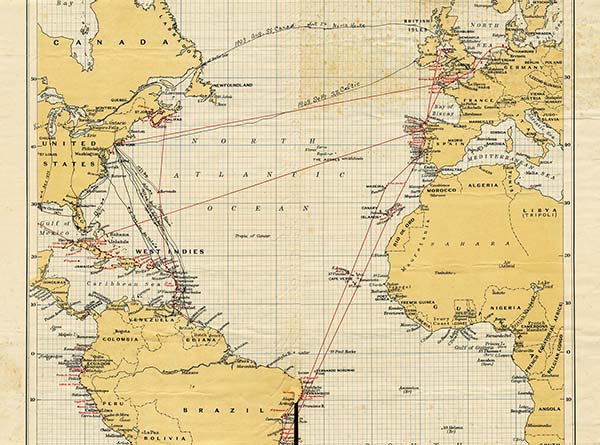
Grandpa had a team
of horses, three cows and a few pigs (for a very short
time). I recall going to the barn and watching Grandpa
milking the cows. He took delight in aiming the teat at
a nearby cat and squeezing milk into the cat's face.
Twice a day and every day in the week he would do the
milking, carry the milk pail up to the house and pour it
into a big metal milk can which was then taken to the
milk factory every morning.
I don't believe this
diagnosis, made in the home without any diagnostic
aids: no x-rays and no lab tests. There was never any
mention that Grandpa was jaundiced, certainly not in his
casket where Aunt My -- to reassure me but instead shock
me to my core -- leaned over and kissed him. (Part of
my shock was that Aunt My never kissed anyone.)
Undertaking fluids can wash out some of the bile
pigments. He did not look wasted or cachectic.
In one place it is
mentioned that he had a short illness; in another,
Mother says he had been failing all winter. I only was
aware of his illness for about two weeks. Cousin Lamott
was called in consultation from Durand and there was
mention of his tapping out a fluid level in the chest.
In that time, people
died of whatever the local physician said they died
from, no autopsies and no questions asked.
Incidentally, Father
watched the undertaker embalm the body. The casket was
in front of the picture window overlooking the front
lawn and the service was held in the living room.
Wilma's contemporaneous
account, in a letter written to Emily, April 21:
I wrote Ivalita this
morning and told you about Grandpa. The doctor didn't
come til just before noon. He says his condition is
very serious ? that he is turning blue, then clearing up
showing that his system isn't taking care of the
poisons. Papa has gone up now to talk with Grandma
about having a doctor in for counsel. I phoned Aunt Boo
& she will come home tonight. I'm sure Grandma will be
glad to have her. Aunt My is so nervous and can't
control herself. I am cool & collected here at home and
do the telephoning. Will go up this p.m. Will phone
you when we need you, dear. Be brave, it's going to be
hard for all of us.
Papa has just come in. He says Grandma is trying hard
to control herself but is in bad shape. LaMott is
coming up from Durand this afternoon.
Grandpa looks bad. His pulse is coming up all the time
and his breathing is gaspy, papa says.
Richard's further
recollection:
Though but nine
years old, I remember Lamott coming from Durand to
consult, but it seems to me it was a few days before
death. He was said to have percussed a fluid level in
the chest. This letter clears up one question: The
death certificate says he died of "Acute Cholecystitis"
-- gall bladder disease -- but I never heard that he was
jaundiced, the sine qua non of that diagnosis.
Indeed, this letter says he was blue -- not yellow --
had a rapid pulse and was short of breath, all
compatible with heart or lung disease. Mother once wrote
that he had "been failing all winter" and at another
time that he died "after a short illness." Nowhere is
there mention of pain, fever, cough or swelling. Take
your pick: pneumonia, pulmonary emboli, congestive
heart failure.
Grandfather was
blue-eyed and had spent many months under a tropical sun
and in the orchards. Apples were sprayed several times
a year with "Bordeaux Mixture" of arsenate of lead and
limed sulfur. I have seen both Grandpa and the hired
man coated with spray -- they never wore masks, so
arsenic inhalation must have been inevitable. From the
sun and/or the arsenic, he had severe keratoses of the
back of his hands that he used to rub with "bag balm"
and "Skin-Ku-Rill.'' It would not be surprising if some
of these lesions were malignant, but I don't think this
was a cancer death.
Correspondence is found on
the next page.
|
